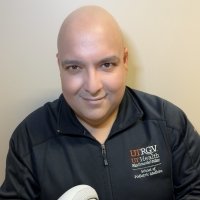Pioneering New Paths in Medical Education

"This program provided a comprehensive foundation in evidence-based teaching methods, curriculum design, and learner assessment, areas that many faculty in academic medicine don’t often focus on."
Hooman Mir, DPM, MSci, FAPWCA, is a DPM physician by training and a full-time tenure-track assistant professor at the University of Texas Rio Grande Valley (UTRGV) School of Podiatric Medicine, with a deep background in podiatric medicine, academic medicine, and surgical education. By the time he enrolled in the Training to Teach in Medicine program at Harvard Medical School, Mir had already created virtual training labs, surgical training workshops, taught surgical anatomy and led academic initiatives in United States & Abroad. Still, he recognized a critical gap in his professional development: formal training in medical education.
“I saw an urgent need for transformative teaching methods in medical education, especially in diabetic wound care,” Mir explains. After the pandemic disrupted traditional instruction, he noticed physician students were struggling to re-engage. “I was introduced to the Training to Teach in Medicine program, and I saw it as a unique opportunity to gain the educational skills we often don’t receive in medical or residency training.” Mir is also proud to be the first Doctor of Podiatric Medicine (DPM) to complete the program and to be inducted into the Harvard Club of Boston.
Transformative Impact on Teaching and Personalized Medicine
Mir credits the program with reshaping both his teaching philosophy and career trajectory. “The program was completely transformative for my career,” he says. “It provided a comprehensive foundation in evidence-based teaching methods, curriculum design, and learner assessment, areas that many faculty in academic medicine don’t often focus on.”
He quickly integrated lessons from the program into his course design at UTRGV, applying learner-centered strategies in courses such as Language of Medicine and Lower Extremity Anatomy. “I wanted to create an environment where physician students actually retain what they learn, not just memorize for an exam,” he explains.
The experience also motivated Mir to pursue a PhD in medical genetics with a concentration in personalized medicine for diabetic populations at UTRGV, School of Medicine. “That decision was 100% the result of the Training to Teach in Medicine program,” he says. “It reinforced the value of precision medicine and the collaborative practices needed to manage diabetes effectively.”
Capstone and Mentorship Spark Global Innovation
For his capstone project, Mir developed a 3D visualization-based training technique for diabetic wound classification, an approach inspired by gaps he had observed in both clinician and patient education. “We don’t have effective tools to teach patients how to care for diabetic wounds,” he notes. “My project addresses that by using immersive technology to help patients recognize the seriousness of their condition and seek timely treatment.”
The project has since been implemented as part of his World-Wide Surgical Amputation Workshop series, which Mir delivers on prestigious international medical stages, including Imperial College London, Barts Institute & Barts School of Medicine, and beyond. These workshops serve as global platforms for surgical education, where the next generation of physician leaders engage directly with cutting-edge technology.
Mir also highlights the mentorship he received during the program as a defining part of the experience. “The relationship with Harvard Medical School faculty was incredibly collaborative. I’m still working with some of my mentors on new projects,” he adds.
To those considering the program, Mir offers this advice: “It’s rigorous and time-intensive, but absolutely worth it. This program will empower anyone who wants to become a leader in academic and surgical education.”
Written By: Pamela Searle
